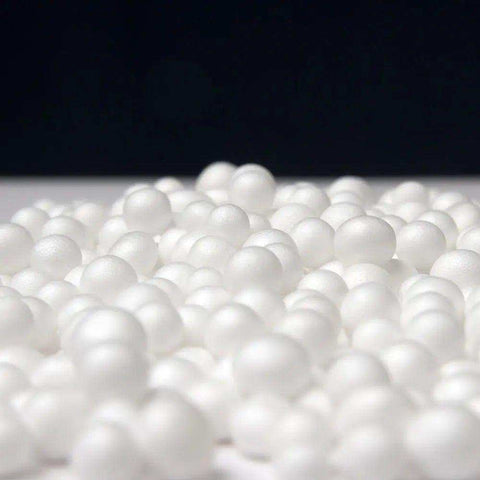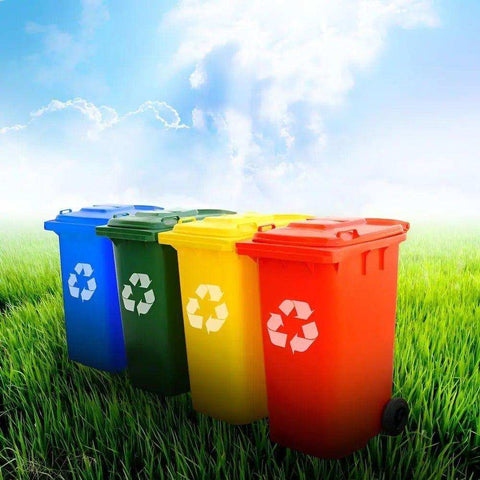Is polystyrene toxic? Many people ask this question, especially when buying bean bags filled with expanded polystyrene (EPS). EPS beads are soft, lightweight, and mould to the body for support. Expanded polystyrene is commonly referred to as 'Styrofoam' in everyday language. Although concerns exist about chemicals in plastics, EPS used in furniture is widely regarded as safe by global health authorities. Additionally, polystyrene is considered safe for food use when in a solid state.
What Is Expanded Polystyrene?
Expanded polystyrene is a closed-cell plastic foam. It’s made by expanding solid polystyrene beads with steam and blowing agents. The styrene monomers used to produce EPS are derived from fossil fuels, which are non-renewable energy sources. The result is a soft yet firm material used in bean bag chairs and packaging. EPS offers excellent insulation and shock absorption.
EPS for bean bags is typically made from virgin beads. These are new, smooth, and rounded. According to Dyplast Products, EPS includes trace levels of styrene and pentane, which raises the question: Is polystyrene carcinogenic?

Types of Polystyrene and Their Uses
Polystyrene is a remarkably adaptable plastic material, available in several forms that serve different purposes in our daily lives. The most common types are expanded polystyrene (EPS), extruded polystyrene (XPS), and high-impact polystyrene (HIPS). Expanded polystyrene EPS is best known for its use in food packaging, such as polystyrene foam cups, takeout containers, and trays, thanks to its lightweight structure and excellent insulation properties. This makes it ideal for keeping foods hot or cold during transport. Extruded polystyrene, with its denser and more moisture-resistant properties, is widely used in building insulation and construction materials. High-impact polystyrene is tougher and more flexible, making it suitable for products such as plastic containers, disposable cutlery, and various packaging materials. Understanding these different types of polystyrene helps consumers and manufacturers make informed choices about which material is best suited for specific applications, especially when considering the environmental and health impacts of polystyrene plastic in food and packaging.
Is Styrene Harmful?
Styrene, a volatile colourless liquid, is a chemical used to make EPS. It evaporates quickly during production. Less than 0.2% of EPS contains styrene once fully processed. The International Agency for Research on Cancer classifies it as a “possible” carcinogen. Furthermore, the International Agency for Research on Cancer (IARC) has classified styrene as a probable human carcinogen.
This means long-term, high-level exposure in workplaces may pose some risk. Certain workers exposed to high levels of styrene show increased risks for lymphohematopoietic cancers such as leukemia and lymphoma. But it does not mean polystyrene is carcinogenic in consumer settings like your home.
Polystyrene Food Packaging and Consumer Safety
The Centers for Disease Control and Environmental Protection Agency agree that EPS products pose no known health risks to consumers. They stress that typical contact with EPS—such as in bean bags—is safe.
Styrene must be inhaled or absorbed in large quantities to pose a hazard. A sealed bean bag filled with EPS beads poses virtually no exposure risk.
Workplace Exposure vs. Home Use
The Occupational Safety and Health Administration allows workers to be exposed to 100 ppm of styrene over an eight-hour shift. Short-term exposures can go up to 600 ppm. The ACGIH suggests stricter exposure limits—just 20 ppm.
However, studies have shown that workers exposed to high levels of styrene have an increased risk of lymphohematopoietic cancers. And EPS bean bag filling releases far less styrene than these limits. So, is polystyrene carcinogenic? In household use, all signs indicate 'no'.
Ratings by Safety Organizations
The HMIS and the NFPA give EPS a safety rating of 1 out of 4. That rating is very low. It means EPS may cause minor, reversible irritation—but only in specific industrial contexts.
EPS used in bean bags is fully cured. There is no active gas release, no flaking, and no significant risk of irritation.

Inhaling or Ingesting EPS
What happens if EPS beads are swallowed or inhaled? The risk is not chemical. EPS does not contain toxins harmful in small amounts. However, it can pose a choking risk, especially for kids.
That’s why today’s bean bags include safety zippers and double stitching. These precautions keep the beads inside and children safe.
Can EPS Cause Health Symptoms?
Freshly cut or crushed EPS can produce fine dust. This may irritate the lungs or eyes. However, EPS dust is not toxic. It can cause minor symptoms like coughing or sneezing, similar to dust from flour or sawdust.
With proper use, EPS in bean bags does not create dust. If left intact, the beads are completely inert and safe for daily use.
Is Polystyrene Toxic in the Long Term?
Scientific studies on polystyrene and cancer have not confirmed a direct link. However, studies suggest a possible link between polystyrene exposure and adverse health effects, though evidence is not definitive. Most research concerns long-term occupational exposure to pure styrene, not EPS foam. Animal studies have investigated the effects of polystyrene and styrene exposure, showing various physiological impacts. Some research has highlighted the potential toxicity of polystyrene particles, especially at the cellular level. Developmental toxicity has been observed in some studies involving early life stages of model organisms exposed to microplastics. Laboratory experiments using cell lines have been used to assess the effects of polystyrene nanoparticles. Exposure to polystyrene particles can lead to cell death in certain experimental conditions. Genetic damage has been reported in studies examining the effects of styrene on blood cells. Again, the keyword 'polystyrene carcinogenic' appears in health discussions, but the answer under normal use remains 'no'.
For families using EPS-filled bean bags, the exposure is minimal and considered non-hazardous.
Environmental and Health Impact
EPS does not biodegrade quickly, which creates concerns for landfills. Plastic particles from polystyrene can contaminate soil and water. Polystyrene pollution is also a major issue in aquatic environments, including both freshwater and marine ecosystems. The marine environment is particularly affected by the accumulation and persistence of polystyrene debris. PS microparticles are a significant source of microplastics in the environment, and PS particles of various sizes are commonly found in environmental samples, where they can interact with biological systems. Primary microplastics, which are intentionally manufactured, differ from secondary microplastics that result from the breakdown of larger debris. As polystyrene breaks down further, nanoplastic particles can form, increasing the risk of environmental and biological exposure. Flame retardants are sometimes added to polystyrene products and can pose additional health risks. Incineration of polystyrene can release polycyclic aromatic hydrocarbons, which are hazardous to health and the environment. Plastic nanoparticles delivered to the environment can be transported and internalised by organisms, leading to potential toxic effects. Studies often measure final concentrations of polystyrene particles in environmental and biological samples to assess exposure and risk. The physical properties of polystyrene, such as particle size and surface characteristics, influence its environmental behaviour and interactions. Cellular uptake of polystyrene particles has been observed in various organisms, and in some cases, these particles can penetrate blood vessels. Exposure to polystyrene and its additives has been linked to effects on white blood cells. Wildlife exposed to microplastics, including polystyrene, have shown behavioural disorders, and fish-induced effects have been documented in aquatic species exposed to polystyrene micro- and nanoplastics. Styrene and other chemicals can migrate from polystyrene into indoor air, affecting air quality. Recycling polystyrene food packaging is challenging due to contamination and low recycling rates. Food containers made from polystyrene can contribute to microplastic contamination. Human consumption of microplastics can occur through contaminated food and water. Safer alternatives are being adopted to mitigate these risks. Overall, polystyrene products have a broad impact on both health and the environment.
If you’re concerned about both safety and sustainability, opt for high-quality EPS from reputable, ethical manufacturers. Avoid recycled beads that may contain impurities. Polystyrene is difficult and expensive to recycle, resulting in most of it being sent to landfills or littered.
Impact on the Food Chain
The widespread use of polystyrene foam in food packaging has raised significant concerns about its impact on the food chain. When polystyrene foam, particularly expanded polystyrene EPS, is used to store or serve hot foods, it can release toxic substances such as styrene monomers into the food. These harmful chemicals may then be ingested, potentially leading to health problems over time. Beyond direct human exposure, polystyrene breaks down into smaller particles—microplastics and nanoplastics—that can contaminate water, soil, and eventually enter the food chain. Marine animals and other wildlife may ingest these particles, which can then move up the food chain and ultimately reach humans. This cycle highlights the risks associated with polystyrene in food packaging. It underscores the importance of seeking safer alternatives and more sustainable materials to protect both human health and the environment.
Uptake of Plastic Nanoparticles
Recent laboratory experiments have demonstrated that plastic nanoparticles, including polystyrene nanoparticles (PS-NPs), can be taken up by living cells. Factors such as particle size, surface charge, and the presence of chemical additives influence how these tiny particles interact with human cells, including epithelial cells and endothelial cells. Once inside the body, PS-NPs may cause toxic effects, potentially disrupting normal cellular functions. The uptake of these plastic nanoparticles can occur through ingestion, inhalation, or even skin contact, raising concerns about the health risks associated with exposure to polystyrene plastic in everyday products. As research continues, understanding how PS-NPs are taken up by human cells is crucial for assessing potential dangers and guiding the development of safer materials and practices.
Disposal and Recycling of Polystyrene Foam
Disposing of polystyrene foam presents significant challenges due to its bulky and lightweight nature, as well as its low recycling rates. Most curbside recycling programs do not accept polystyrene foam, making it difficult for consumers to recycle this material responsibly. The recycling process itself is often costly and energy-intensive, which discourages widespread adoption. As a result, large amounts of polystyrene foam end up as plastic waste in landfills or as litter, contributing to environmental pollution and the growing problem of plastic materials in our ecosystems. Addressing these issues requires investment in more efficient recycling technologies and a shift toward sustainable practices in the production and disposal of polystyrene plastic.
Regulation and International Cooperation
Efforts to regulate polystyrene plastic and promote international cooperation are gaining momentum as awareness of its environmental and health impacts grows. Many countries and cities have introduced bans or restrictions on polystyrene foam in food packaging, encouraging the use of safer alternatives. Policies such as extended producer responsibility (EPR) are being implemented to make manufacturers more accountable for the lifecycle of their products, including recycling and disposal. International collaboration is essential for sharing best practices, developing innovative solutions, and tackling the global challenge of polystyrene plastic pollution. By working together, governments, industries, and consumers can help reduce reliance on polystyrene foam and move toward a more sustainable future for food packaging and plastic materials.
Alternatives to EPS Filling
Some eco-minded consumers prefer organic bean bag fillers. Options include buckwheat, recycled foam, or memory foam flakes. These materials are biodegradable or reusable—but heavier and often more expensive.
Virgin EPS remains one of the best combinations of affordability, safety, and ergonomic comfort.
Best Practices for EPS Safety
- Choose virgin EPS over recycled alternatives
- Keep bean bags zipped at all times
- Keep away from open flame or high heat
- Clean up any spills immediately
- Supervise children near bean bags
Final Answer: Is Polystyrene Toxic?
So, is polystyrene carcinogenic? Not in the form used in bean bag furniture. Health organizations agree that EPS poses no risk under ordinary use. It's safe for kids, adults, and indoor use when sealed in liners.
For peace of mind, always choose products from reputable suppliers like Bean Bags R Us, who use tested, certified EPS filler for maximum comfort and safety.





